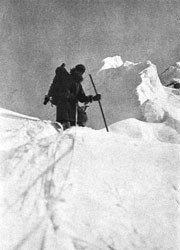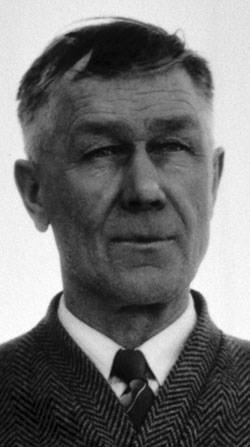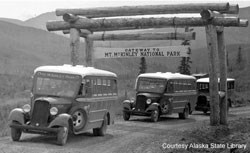TRANSCRIPT OF HARRY KARSTENS RADIO INTERVIEW Running time for this version 08:05 Audio of unknown provenance edited and transcribed in February 2013 by Jay Elhard of Denali National Park and Preserve
ANNOUNCER: Seven-thirty on Wednesday evening, it's time for “Here's A Pioneer.” It's a weekly presentation of the Pioneer Cab Company, which is located across from the Nordale Hotel on Second Avenue. And their telephone number, 24-hours a day, is (East) One-O-A.
We have this week as a visitor on “Here's A Pioneer,” a distinguished old timer named Harry Karstens. And I feel sure that Harry is so well-known to hundreds of our listeners tonight. Karstens, I think, will be remembered best as one of the leaders of the Karstens-Stuck expedition. The expedition that climbed to Mount McKinley, the very peak.
BREAK
ANNOUNCER: I understand too that your travels with (Charles) Sheldon gave you background for your eventual trip up Mount McKinley. Is that true?
KARSTENS: More or less. He asked me at the time if I'd go with him if he'd make the ascent. I told him sure, I'd take a chance. But he got married when he went Outside and that spoiled it.
ANNOUNCER: That gave up his part in the expedition. Then you eventually decided to combine your efforts with Archdeacon Hudson Stuck. Is that correct?
BREAK
KARSTENS: … To the mountain to make the climb. I didn't feel as though I could afford to do it, I had to make a living. And I was more or less chasing around the country. But I eventually did, and in 1912 I promised him to go. It was a joint undertaking, which he states in his letters, which I have. And we were to share in the book and the articles and so forth.
We started in in the summer of '12. I took the provisions and stuff we needed mostly in by boat, as close as I could to the mountain up the Bearpaw. Then in the spring, it about March, he came in and we got three dog teams together. And there was Tatum, one of the mission boys, 20-year-old, and Walter Harper, 20-years-old, and Deacon and myself were the ones that made the climb. There was two 15-year-old Indian boys that were along to help do the work.
We went in in March with the dog teams, picked up the stuff from where I had cached it at the head of the Bearpaw, and freighted it in to the base of the mountain, that is, on Willow Creek, and at the foot of the McGonagall Pass, which leads onto the Muldrow Glacier at about, I should judge, about 5,000 feet. Well from there, we used dogs to 11,500, the (Grand Basin). We had doubled-tripped it for a number of trips up there with dogs. Had a good supply of stuff, had silk tents, and quite a lot of mountain grub and equipment. And the last trip we took up the big tent set up, we used wood, we hauled wood up there. But in the last trip up, we got near to where the cache was, we smelled smoke, and in the rush forward we found the cache was on fire.
ANNOUNCER: I imagine that you figured that fire would be the last thing that you'd have to worry about up there.
KARSTENS: We never realized. You wouldn't think there could be a fire, but in some way, it caught afire. Our silk tents were all burnt up, and our clothing, most of it, (indistinguishable) and so forth. And a lot of stuff. Well, the deacon thought we were ruined. But we went through the stuff that we had left and managed to salvage a lot. I sent a couple of the boys down to the base camp to get the canvasses, the (indistinguishable) canvasses, and for three weeks, between storms and working, we made (stock or socks?) and I built a tent.
ANNOUNCER: I imagine then that you were pretty well equipped again when you decided to keep going up.
KARSTENS: Yup, we were fairly well equipped. We had a quite a lot of kerosene, plenty. We had plenty of provisions. But especially we were shy on the (indistinguishable) and stockings and so forth that were burned up.
ANNOUNCER: How did the rest of the trip go, though?
KARSTENS: Well, it was a matter of, it wasn't such a difficult thing except for the northeast ridge, which is called Karstens Ridge.
BREAK
KARSTENS: … different part of the whole climb. After Herschel Parker was up on the mountain and got within 500 feet of the top, they had to come down on account of a strong wind up there that was going and probably would have blown them off. Also, they were short of grub. They came down and that night when they got down there was a big earthquake, shook the whole mountain. And it shattered the Kartens Ridge and the lower end broke off and went down into the valley thousands of feet on either side. That left a cave-in of about 50-foot of ice halfway up the ridge, which was at angles of about 45 degrees. And that had to be worked around. Well, that was some difficulty.
ANNOUNCER: And how did you find the top of the mountain itself? Were you pretty well tired out by the time you got up there?
KARSTENS: Well, it wasn't exactly tired. It was merely that the exertion was great. Breathing. You go a few hundred steps and you'd be breathing, panting, trying to get breath. But we found out that while sitting down before getting up, keep up panting hard, and then get up and walk, get a lot of oxygen into the lungs.
ANNOUNCER: Now I'd like to know about the very moment when you ascended the top of the mountain, who was the first of your party, I understand there were four of you, to get to the top? Who was the first?
KARSTENS: Well, I believe at the time I kept Walter Harper in the lead, and going up, I thought it was no more than fair to leave him there.
ANNOUNCER: So he was the first one to be on top. I see, Walter Harper, 20-year-old Native boy. Now I understand that you made a rather quick trip down, didn't you?
KARSTENS: Yes, it was only a two-day trip down. That was because of (indistinguishable) the lower glacier, around all the crevasses and building snow bridges across the crevasses.
ANNOUNCER: Well Harry, our time is up now, and we'll have to call it quits on this interview. I feel that I could spend hours with you and would certainly enjoy it talking about your adventures, especially in connection with Mount McKinley.
Friends, we've listened to an interview with Mr. Harry Karstens, one of the partners of the Karstens-Stuck expedition which climbed Mount McKinley. What year did you say was that was, Harry?
KARSTENS: 1913
ANNOUNCER: 1913. Well, thank you ever so much, Harry Karstens.
Friends, you've listened to “Here's A Pioneer,” brought to you by the Pioneer Cab Company each Wednesday evening at 7:30. Pioneer Cab Company located across from the Nordale Hotel, telephone anytime (East) One-O-A.





